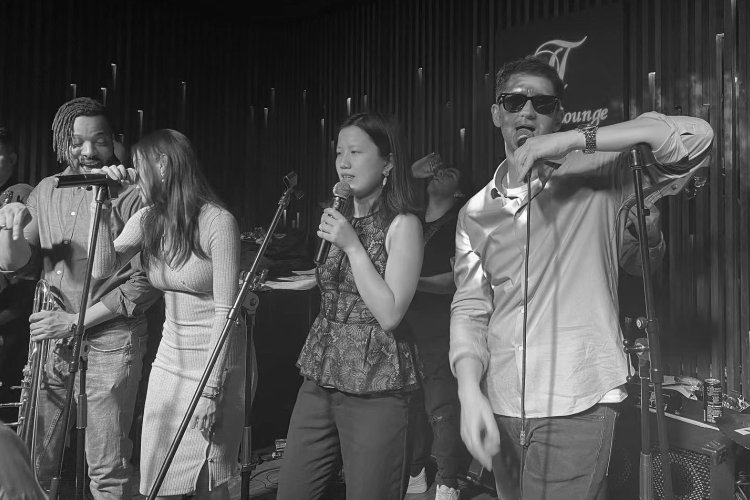All the Right Moves: Shash belly dancer Albena
Belly dancer Albena’s background reads like a Central Asian atlas – an ethnic Azerbaijani, she was born in Kazakhstan and raised in Uzbekistan, where she learned her sensual art. A Beijing resident since 2008, she is now the primary dancer at Shash, the CBD-area Uzbekistani restaurant known for its opulent interior decorations (featuring giant hand-painted murals, woven tapestries, and massive chandeliers) and traditional Uzbek dishes like lamb puff pastry, spicy rice pilaf accompanied by Russian vodkas and Georgian wines.
We spoke with Albena to learn more about her life, aspirations and belly dancing, Beijing style.
When did you pick up belly dancing? Who taught you?
I started dancing when I was 7 years old, but it was to learn other types of dancing. When I was 9 years old, I saw a belly dancer and I thought she was so beautiful and graceful, so I started learning how to belly dance then at school – it’s an important part of the culture, so there are many teachers.
What’s your fondest memory of growing up in Uzbekistan?
I just enjoy hanging out with my friends and family, laughing and talking. I still talk to them frequently online here in Beijing.
What made you decide to come to Beijing to work?
I am about to go back to school soon to get my degree in dancing and arts, so I felt this international opportunity at Shash was a great one, and I can use it to show people how important dancing is to me.
Are there a lot of belly dancers here in Beijing? Have you found a community?
I haven’t yet, but I also don’t have much free time because I perform at Shash a lot. I think it’s becoming more and more popular because it is such a good way to enjoy yourself and stay in shape.
What’s your practice schedule like? How do you perfect your art?
I practice or dance every day for five to six hours. I dance at the restaurant and practice at home.
How can others get started belly dancing?
It’s hard to just start out of nowhere because you need to have a flexible body. It also helps if you’ve practiced other dancing because then your body can move gracefully. The hardest part for newcomers is that you have to be very flexible. For me, nothing is difficult because I have been dancing for so long and I practice frequently. But for new dancers, the entire dance itself might be difficult because you have to learn to move your entire body.
Were you embarrassed your first time?
I was only 13 years old the first time I belly-danced in public, so yes, I was a little bit embarrassed. However, that passed very quickly because after all, it’s just one kind of dance, one kind of art.
Is it a good way to stay in shape?
What body area does it help the best?
Yes, I don’t do any other type of exercise, only dancing. I can eat absolutely anything I want, and I can stay in fantastic shape. However, you can’t be too skinny. Many of our clients do not like skinny dancers even if they are good dancers. You must have curves, must be a woman, basically, you must have a good top and bottom [ha ha]!
It helps all of the parts because you move your entire body to the music. Belly dancing is not only for professionals; many women do this at home just as a hobby because it is part of the culture. I have heard that because of belly dancing, women in India and Arabic countries have the lowest levels of uterine cancer.
Have you learned any new belly dance routines since coming to Beijing?
The new routines that I learn are all from the videos online. There are new moves every once in a while, so I make sure to check the websites frequently.
What’s your favorite place to eat in Beijing?
Of course Shash because it has the cuisine of my homeland. Uzbekistan is a very multi-ethnic country, so Shash has food from North Korea, Russia, Kazakhstan, Georgia, Chechnya, etc. If I’m not eating here, I will cook at home.
What’s your favorite Uzbek dish?
One is the lamb puff pastry. They bake it here in the oven at Shash. We have two big tandoori ovens upstairs to make traditional Uzbek pastries.
When you’re not shaking it, what do you do for fun?
I like to watch dancing videos to see what the new moves are. I like to go online and chat with my friends. Also, I love shopping here at Sanlitun and Yabaolu, where there are a lot of Russian vendors. My favorite brands by far are Mango and Zara.
Do you see yourself settling down here in Beijing?
I have already been here for half a year, and I plan to stay for six more months. After that, I will go back to Kazakhstan and study at the arts university there to get my dancing degree because I want to open my own dancing school. I want it to be open for kids, young adults, and older people.
Will you open it in Beijing?
I like Beijing a lot because it is different and interesting. I see that more and more people want to learn, so maybe Beijing. I am hoping it will be an international chain eventually. Dancing is like a narcotic to me. If I do not dance during the day, I feel horrible the entire day. I hope other people can find something they are as passionate about as I am about dancing.
Shash
Daily 11am-11pm (live music and dancing start at 7pm). 10 Xiangjun Beili (inside the Third Ring Rd., next to St. Angel Hotel), Chaoyang District (5190 7230) 朝阳区呼家楼向军北里4巷10号
Guowei Belly Dancing
Try a free class anytime from Tuesday-Friday at 6.30pm. One-hour classes held Monday-Friday 6.30-8.30pm, and Sunday 2.30-4.30pm. Bldg 1, 3/F, Jianwai Soho, Chaoyang District, Beijing (opposite the China World Trade Center) 朝阳区建外SOHO 1号楼(5869 4816)
Pussycat Dance
One of Beijing’s first ladies-only dancing studios, Pussycat Dance offers foreign teachers and free-makeup courses in belly dancing. Bldg 3, Rm906, Jianwai Soho, Chaoyang District 朝阳区建外SOHO 3号楼906室 (5900-0835)
Interview by Jennifer Ying Lan; Taken from the April 23rd edition of Agenda, out around town now. To find out where to grab a copy, send an email to distribution@agendabeijing.com






